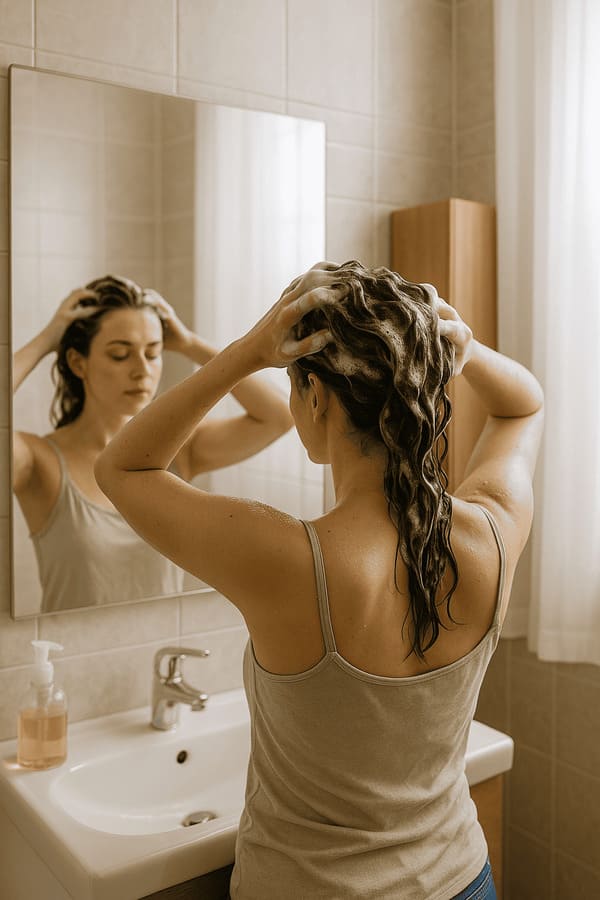Do you want hair that is always in top form , healthy and shiny but instead it is frizzy, untamed and dull? Can't find the right products to make your dream come true? You probably don't know your hair type!
Just as it is good to know your skin type for an effective skincare routine, it is just as important for your hair care routine to know your hair type!
Straight, wavy or curly, but not only! There are 12 types of hair texture!
Among the variables we can then add the quantity of sebum, the porosity and the type of scalp, the latter too often overlooked! The scalp is not visible but it is absolutely important, it is where our hair sinks its roots!
Plot
Texture is what defines hair as straight, wavy, or curly! Here are the 12 categories from straight to super curly!
1A Smooth and thin
1B Smooth and thick
1C Smooth Wavy
2A Wavy and thin
2B Wavy and thick
2C Wavy and very thick
3A Soft hedgehog with a large diameter
3B Spiral Curls
3C Corkscrew curls
4A Very tight curls
4B Ricci Z-shaped or S-shaped
4C Afro Curls
To find out what texture your hair has, just use a neutral shampoo and let it air dry without brushing it or applying products.
Now look at them dry and you will know what texture they have!
Structure
Hair structure is what defines hair as fine, normal or thick and refers to their diameter! The structure has a big impact on styling !
To recognize the structure of your hair you need a sheet of paper , a cotton sewing thread of a similar color to your hair and a hair of yours left in the comb. Place your hair and the thread on the white sheet and compare them.
- Fine hair: Your hair is thinner than the thread
- Normal hair : your hair is like thread
- Thick hair: Your hair is thicker than the thread
Porosity
Does your hair absorb or resist moisture and products? Its absorption capacity is determined by its porosity!
But how do you understand the porosity of your hair? If you have long hair , take a lock of your hair and place it in a bowl of water.
- Does it sink in completely? Your hair has high porosity, which means it absorbs a lot of moisture!
- Floating but under the surface? Your hair is medium porosity!
- Floating on the surface of the water? Your hair is low porosity!
Sebaceous secretion
A further classification of hair is that linked to the sebaceous secretion of the scalp , which we will talk about shortly below.
The sebaceous glands located at the base of the hair follicle from which the hair grows secrete sebum which forms the hydro-lipid mantle that protects the scalp and moistens, protects from external agents and decreases the permeability of the hair shaft.
To understand if you have dry, frizzy, normal or greasy hair , it is good to take a look at it the day after washing it with only natural and neutral shampoo and without having applied any product before or after.
- Dry hair: it gets dirty a few days after washing, it doesn't appear greasy, it is delicate, it breaks easily and it looks frayed with split ends at the ends.
- Frizzy hair: This is untamed dry hair, it swells and reacts immediately to atmospheric conditions, it is fragile, dull and rough to the touch.
- Normal hair: can be washed, in normal conditions, every three days. It appears shiny and soft. This is the hair we all want!
- Greasy hair: it gets dirty the day after washing and immediately appears greasy at the roots.
Scalp
How is your scalp? Is it dry, oily or normal? The health of your scalp is crucial to the health of your entire hair, as it gets nourishment from there!
As you have learned by now, wash your hair with natural and neutral shampoo. Do not apply products before or after and then give your scalp a little check!
-
The scalp is in excellent shape: it is light pink, smooth and does not flake . Dead cells fall off imperceptibly.
-
Dry scalp : it is unable to get rid of dead cells in time, which then accumulate, causing flaking and itching, dry dandruff. If it gets very irritated, it can cause seborrheic dermatitis.
-
Oily scalp : excessive sebum production that is deposited at the base of the hair, which becomes greasy and often itchy. It is often associated with greasy dandruff, a white flake with large, greasy scales associated with itching. It is due to the accumulation and greasiness of dead cells that cannot fall off. suffocation by sebum from increased cell turnover of the skin.
- Sensitive scalp : no visible abnormality but it is a scalp that itches, burns and is hypersensitive. The hair “hurts” if moved or tied. Often the external causes are due to aggressive shampoos, pollution, stress, particular medications or internal causes such as hormonal changes.
Now that you know how to recognize your hair type, you can move on to the next step! Discover in this article how to choose the products for your hair !
Continue reading our articles to find out how to always have healthy and beautiful hair naturally in our hair guides and tutorials section!
[ApSC sc_key=sc3148331291][/ApSC]







